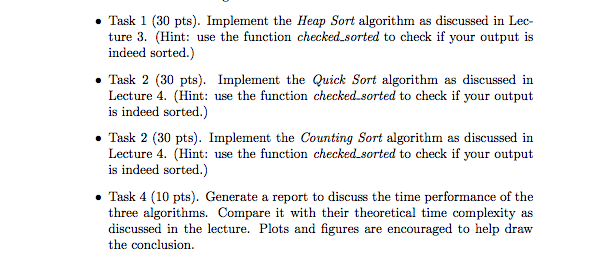Question
package sorting; import java.util.*; public class Sort2 { public static int left (int i) { /* * fill in your program */ } public static

package sorting;
import java.util.*;
public class Sort2 {
public static int left (int i) {
/*
* fill in your program
*/
}
public static int right (int i) {
/*
* fill in your program
*/
}
public static int parent (int i) {
/*
* fill in your program
*/
}
public static int[] max_heapify (int[] array, int heap_size, int i) {
/*
* fill in your program
*/
}
public static int[] build_heap (int[] array) {
/*
* fill in your program
*/
}
public static int[] heap_sort (int[] array) {
/*
* fill in your program
*/
}
public static int[] quick_sort (int[] array, int p, int r) {
/*
* fill in your program
*/
}
public static int partition (int[] array, int p, int r) {
/*
* fill in your program
*/
}
/*
* the values in array range from 0 to k
*/
public static int[] counting_sort (int[] array, int k) {
/*
* fill in your program
*/
}
/*
* n: the size of the output array
* k: the maximum value in the array
*/
public static int[] generate_random_array (int n, int k) {
List
int[] array;
Random rnd;
rnd = new Random(System.currentTimeMillis());
list = new ArrayList
for (int i = 1; i
list.add(new Integer(rnd.nextInt(k+1)));
Collections.shuffle(list, rnd);
array = new int[n];
for (int i = 0; i
array[i] = list.get(i).intValue();
return array;
}
/*
* n: the size of the output array
*/
public static int[] generate_random_array (int n) {
List
int[] array;
list = new ArrayList
for (int i = 1; i
list.add(new Integer(i));
Collections.shuffle(list, new Random(System.currentTimeMillis()));
array = new int[n];
for (int i = 0; i
array[i] = list.get(i).intValue();
return array;
}
/*
* Input: an integer array
* Output: true if the array is acsendingly sorted, otherwise return false
*/
public static boolean check_sorted (int[] array) {
for (int i = 1; i
if (array[i-1] > array[i])
return false;
}
return true;
}
public static void print_array (int[] array) {
for (int i = 0; i
System.out.print(array[i] + ", ");
System.out.println();
}
public static void main(String[] args) {
// TODO Auto-generated method stub
int k = 100;
System.out.println("Heap sort starts ------------------");
for (int n = 10; n
int[] array = Sort2.generate_random_array(n);
long t1 = System.currentTimeMillis();
array = Sort2.heap_sort(array);
long t2 = System.currentTimeMillis();
long t = t2 - t1;
boolean flag = Sort2.check_sorted(array);
System.out.println(n + "," + t + "," + flag);
}
System.out.println("Heap sort ends ------------------");
System.out.println("Quick sort starts ------------------");
for (int n = 10; n
int[] array = Sort2.generate_random_array(n);
long t1 = System.currentTimeMillis();
array = Sort2.quick_sort(array, 0, n-1);
long t2 = System.currentTimeMillis();
long t = t2 - t1;
boolean flag = Sort2.check_sorted(array);
System.out.println(n + "," + t + "," + flag);
}
System.out.println("Quick sort ends ------------------");
System.out.println("Counting sort starts ------------------");
for (int n = 10; n
int[] array = Sort2.generate_random_array(n, k);
long t1 = System.currentTimeMillis();
array = Sort2.counting_sort(array, k);
long t2 = System.currentTimeMillis();
long t = t2 - t1;
boolean flag = Sort2.check_sorted(array);
System.out.println(n + "," + t + "," + flag);
}
System.out.println("Counting sort ends ------------------");
}
}
. Task 1 (30 pts). Implement the Heap Sort algorithm as discussed in Lec- ture 3. (Hint: use the function checked sorted to check if your output is indeed sorted.) Task 2 (30 pts). Implement the Quick Sort algorithm as discussed in Lecture 4. (Hint: use the function checked.sorted to check if your output is indeed sorted.) . Task 2 (30 pts). Implement the Counting Sort algorithm as discussed in Lecture 4. (Hint: use the function checkedsorted to check if your output is indeed sorted.) Task 4 (10 pts). Generate a report to discuss the time performance of the three algorithms. Compare it with their theoretical time complexity as discussed in the lecture. Plots and figures are encouraged to help draw the conclusionStep by Step Solution
There are 3 Steps involved in it
Step: 1

Get Instant Access to Expert-Tailored Solutions
See step-by-step solutions with expert insights and AI powered tools for academic success
Step: 2

Step: 3

Ace Your Homework with AI
Get the answers you need in no time with our AI-driven, step-by-step assistance
Get Started


